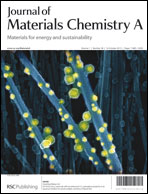Pyrite nanorod arrays as an efficient counter electrode for dye-sensitized solar cells†
Abstract
Pyrite (FeS2) nanorod arrays were produced on a fluorine doped tin oxide substrate by sulfurizing FeO(OH) nanorods, and then tested as the counter electrode (CE) for dye-sensitized solar cells (DSSCs). FeS2 nanorods show better catalytic properties than the FeS2 film and the Pt film due to their active facets, which helps to achieve a high short-circuit photocurrent density (Jsc) of DSSCs. On the other hand, FeS2 nanorods have lower interface resistance than FeS2 thin films, which contributes to a higher fill factor (FF) of DSSCs. As a result, the solar cell with a CE of FeS2 nanorods exhibits an excellent power conversion efficiency, which is comparable to that of traditional DSSCs with a Pt CE.


 Please wait while we load your content...
Please wait while we load your content...